Pairing tea herbs together in your garden enhances both growth and flavor. You'll create a vibrant ecosystem that promotes nutrient sharing and attracts beneficial insects. This natural balance reduces pests and disease risk, giving your plants the best chance to thrive. By combining herbs like mint with lemon balm or chamomile with lavender, you can enjoy unique and delightful flavors in your beverages. Additionally, a diverse garden enhances aesthetics, making your space more inviting. Experimenting with plant combinations not only supports overall health but also opens up exciting possibilities for your teapot. There's so much more to explore about herb pairings!
Benefits of Companion Planting
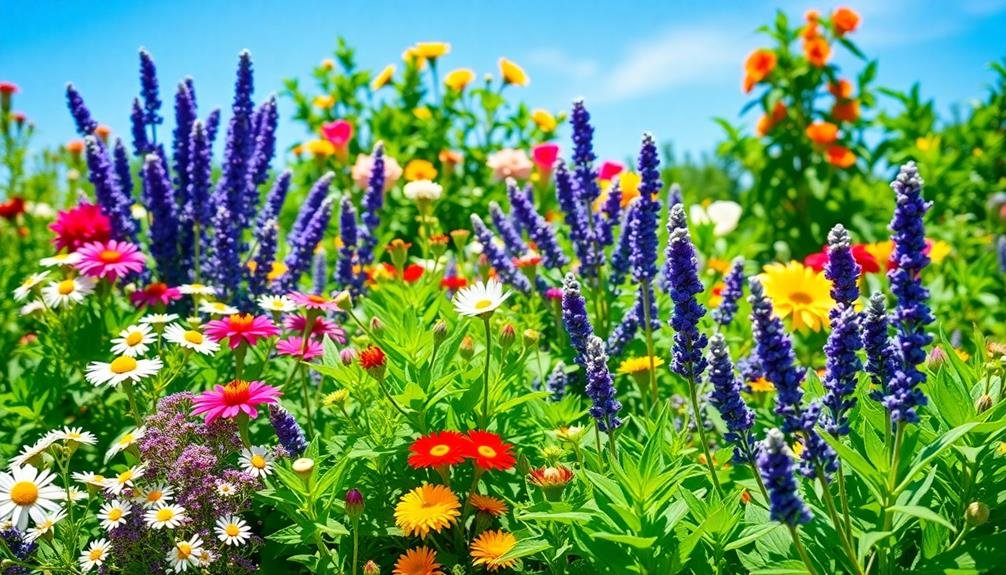
When you consider the benefits of companion planting, you'll find that it can truly enhance your garden's productivity and health. By strategically pairing your tea herbs, you can create a thriving ecosystem that supports growth and reduces pests. For instance, planting mint alongside chamomile can boost both plants' flavors while deterring unwanted insects.
Companion planting also encourages biodiversity, which is essential for a balanced garden. When you mix different species, you attract beneficial insects like pollinators and predatory bugs that help control pests naturally. This means less reliance on chemical pesticides, making your garden healthier for you and the environment.
Additionally, certain plants can improve soil health and nutrient availability. For example, legumes like clover can fix nitrogen in the soil, benefiting neighboring herbs like lemon balm and basil. This promotes healthy growth and can even lead to larger yields.
Lastly, companion planting can protect your herbs from diseases. By spacing out plants that are susceptible to the same issues, you reduce the risk of widespread infection.
Ideal Tea Herb Combinations
To create the perfect tea blend in your garden, consider pairing herbs that complement each other's flavors and growth habits. For a revitalizing morning brew, combine peppermint with lemon balm. The coolness of peppermint balances the citrus notes of lemon balm, creating an uplifting experience.
If you're after a calming evening tea, try chamomile with lavender. Chamomile's gentle sweetness pairs beautifully with lavender's floral aroma, promoting relaxation.
For a spiced twist, mix ginger with turmeric. Both herbs thrive in similar conditions, and their warming qualities make a robust tea that's perfect for chilly nights.
Another excellent combination is basil and holy basil (tulsi). The sweetness of basil enhances the peppery notes of holy basil, offering a unique flavor profile that's both aromatic and soothing.
For a classic blend, consider sage and rosemary. Their earthy tones complement each other, making a rich herbal infusion that's delicious hot or iced.
Experimenting with these combinations not only enriches your garden but also provides a variety of flavors and benefits to your tea-drinking experience. By mixing and matching, you'll discover your personal favorites!
Enhancing Flavor Profiles

Enhancing the flavor profiles of your tea blends can elevate your brewing experience to new heights. By pairing different tea herbs, you can create a symphony of tastes that tantalizes your palate.
For instance, combining mint with chamomile brings a revitalizing twist to the gentle floral notes, while adding a hint of citrus from lemon balm can brighten the entire blend.
Experimenting with contrasting flavors can also lead to delightful discoveries. You might find that the earthy taste of rooibos complements the sweetness of hibiscus, creating a balanced and vibrant brew.
Don't shy away from bold choices, either—spicy ginger can add warmth to a soothing blend of lavender and chamomile, resulting in a comforting cup.
Pest Management Strategies
Managing pests in your tea herb garden can be straightforward and effective.
You can boost your garden's health by using companion planting, employing natural pest deterrents, and enhancing biodiversity.
These strategies not only protect your plants but also create a thriving ecosystem.
Companion Planting Benefits
When you think about creating a thriving tea herb garden, consider the power of companion planting as a strategic tool for pest management. By pairing specific herbs together, you can create a natural balance in your garden that deters pests effectively. For instance, planting mint alongside chamomile can help repel aphids, while basil can keep whiteflies at bay when grown near your favorite tea herbs.
Companion planting also encourages biodiversity, which is essential for a healthy ecosystem. When you mix different plants, you attract beneficial insects like ladybugs and lacewings, which prey on harmful pests. This natural predation reduces the need for chemical interventions, allowing your tea herbs to flourish without the risk of pesticide residues.
Moreover, certain herbs can enhance each other's growth when planted together. For example, rosemary can improve the flavor and health of neighboring plants while providing a barrier against pests.
Natural Pest Deterrents
Natural pest deterrents can play an essential role in maintaining a healthy tea herb garden without relying on harmful chemicals. By strategically pairing your tea herbs with certain plants, you can create a natural barrier against pests. For instance, marigolds emit a scent that repels nematodes and aphids, making them an excellent companion for your tea herbs.
You can also use garlic and chives, as their strong aroma deters various insects. When you plant these alongside your tea herbs, you'll notice fewer pest issues.
Additionally, introducing beneficial insects like ladybugs and lacewings can considerably reduce pest populations, as they feed on aphids and other harmful bugs.
Another effective strategy is to use homemade sprays made from neem oil or soapy water, which can disrupt pests without harming your plants.
Regularly monitoring your garden for signs of infestations allows you to catch problems early, so you can take action before they escalate.
Enhancing Biodiversity Impact
How can enhancing biodiversity in your tea herb garden improve pest management? By fostering a diverse ecosystem, you create a natural balance that helps control pests effectively.
When you combine various tea herbs, you're not just cultivating flavors; you're building resilience against pest pressures.
Here are three ways enhancing biodiversity can aid your pest management strategies:
- Natural Predators: A varied garden attracts beneficial insects like ladybugs and lacewings that prey on common pests. These allies can markedly reduce pest populations without the need for chemical interventions.
- Companion Planting: Certain tea herbs can repel pests when planted together. For example, pairing mint with other herbs can deter aphids and caterpillars, keeping your garden healthier and more productive.
- Microclimate Creation: Diverse plant life helps in creating microclimates that can deter pests. Taller herbs can provide shade and shelter, making it less favorable for pests that thrive in direct sunlight.
Maximizing Growth Potential
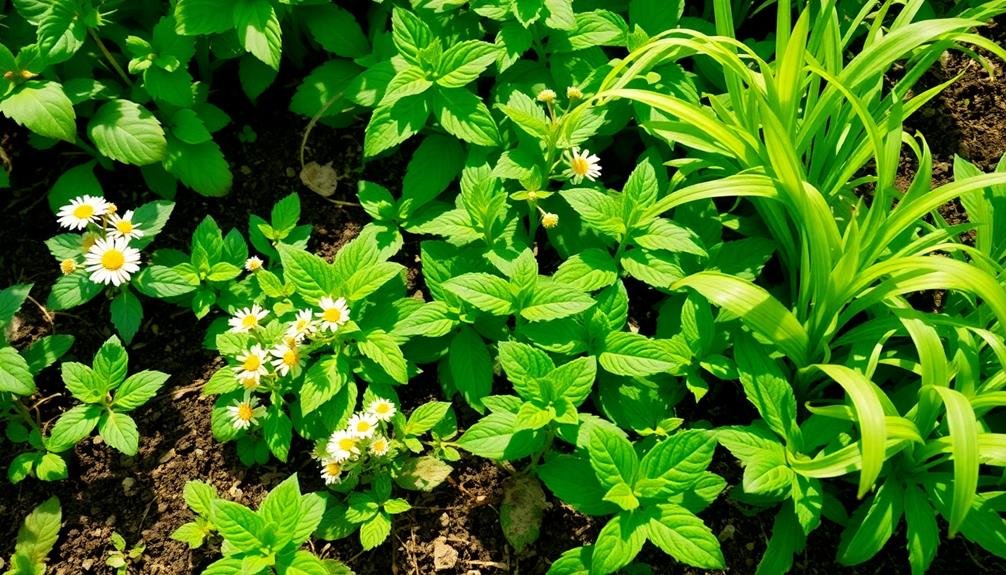
Maximizing growth potential in your tea herb garden starts with understanding the specific needs of each plant. Different herbs thrive under varying conditions, so knowing your plants' sunlight, water, and spacing requirements is essential. Pairing herbs can create a micro-ecosystem that supports their growth, allowing them to flourish together.
Consider this table for effective herb pairings:
| Herb Pairing | Benefits |
|---|---|
| Chamomile & Mint | Chamomile repels pests, mint grows vigorously. |
| Basil & Thyme | Basil enhances thyme's flavor and growth. |
| Lemon Balm & Sage | Lemon balm attracts pollinators, sage deters pests. |
| Lavender & Echinacea | Lavender attracts beneficial insects, echinacea supports pollination. |
Soil Health and Nutrient Exchange
Healthy soil is essential for boosting microbial activity, which plays a key role in nutrient exchange among your tea herbs.
When you pair different herbs together, you enhance their ability to share nutrients, benefiting all plants involved.
You'll notice how this synergy can lead to a more vibrant and productive garden.
Enhanced Microbial Activity
Enhanced microbial activity in your garden's soil is vital for promoting robust plant growth and nutrient exchange. When you pair tea herbs together, you create a thriving ecosystem that encourages beneficial microorganisms to flourish.
These microbes play an important role in breaking down organic matter, making nutrients more accessible to your plants.
Here are three key benefits of enhanced microbial activity in your garden:
- Improved Soil Structure: Microbial activity helps create soil aggregates, which improves aeration and water retention, providing a better environment for root growth.
- Increased Nutrient Availability: Beneficial microbes decompose organic matter and release nutrients like nitrogen, phosphorus, and potassium, ensuring your tea herbs receive the essential elements they need to thrive.
- Disease Suppression: A diverse microbial community can outcompete harmful pathogens for resources, reducing the risk of disease in your plants.
Nutrient Sharing Benefits
One of the remarkable advantages of pairing tea herbs in your garden is the efficient nutrient sharing that occurs between plants. When you grow different tea herbs close together, they can exchange nutrients through their root systems.
Some herbs, like mint, release compounds that can enhance the availability of essential nutrients in the soil, benefiting nearby plants. This symbiotic relationship promotes healthier growth and can lead to more robust flavor profiles in your tea.
Additionally, when you mix different herbs, you create a diverse ecosystem that encourages microbial activity in the soil. These microorganisms play a vital role in breaking down organic matter and making nutrients more accessible to your plants.
The more diverse your garden, the more balanced the nutrient exchange becomes.
Aesthetic Garden Design
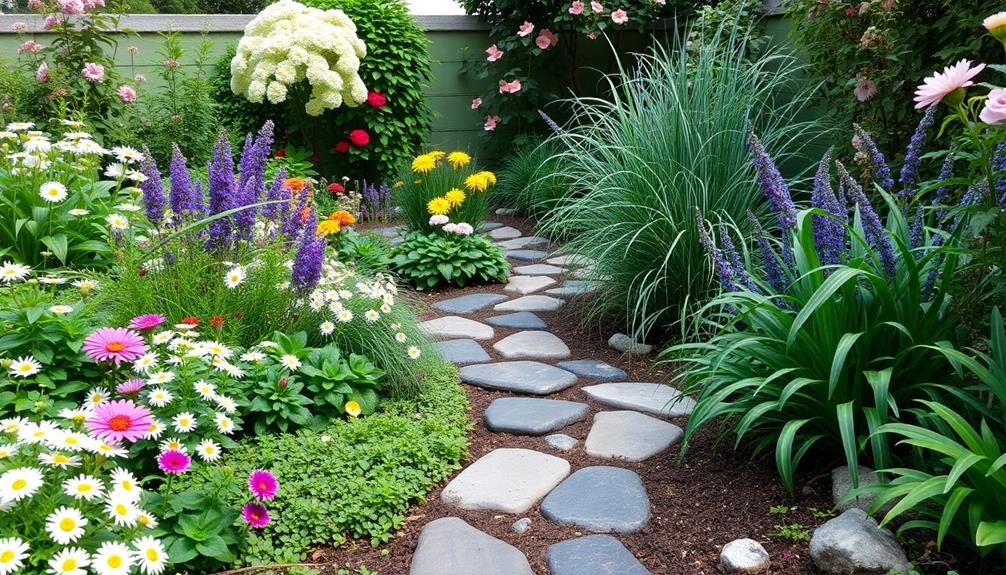
Creating an aesthetic garden design that incorporates tea herbs can transform your outdoor space into a tranquil retreat.
By thoughtfully arranging your tea herbs, you not only enhance the visual appeal of your garden but also create an inviting atmosphere for relaxation and enjoyment.
Here are three ways to elevate your garden's aesthetic:
- Color Coordination: Choose tea herbs with varying foliage colors, from bright greens to deep purples, to create a vibrant contrast. Pairing herbs like chamomile with purple basil can create a stunning visual dynamic.
- Layering Heights: Incorporate herbs of different heights to add dimension to your garden. Taller herbs like mint can serve as a backdrop for shorter varieties like lemon balm, creating a cohesive look.
- Pathways and Borders: Design pathways using stone or mulch that meander through your tea herb garden. This not only guides visitors but also adds structure.
Consider edging your garden with low-growing herbs like thyme to define spaces beautifully.
Seasonal Considerations for Planting
Considering the climate and seasonal changes in your area is essential for successfully planting tea herbs. Different herbs thrive at specific times of the year, so you'll want to align your planting schedule with the seasons.
For instance, many tea herbs, like chamomile and mint, prefer cooler temperatures, making early spring or fall ideal for sowing seeds or transplanting. In contrast, herbs like lemon balm and hibiscus love the heat, so planting them in late spring after the last frost will yield the best results.
You should also consider the length of daylight your herbs need. Some may require full sun, while others thrive in partial shade, especially during the hot summer months.
Pay attention to your region's frost dates too. If you're in a place with unpredictable weather, using row covers can provide extra protection for your plants.
Frequently Asked Questions
Can I Grow Tea Herbs in Containers?
Yes, you can grow tea herbs in containers! Just choose appropriately sized pots, guarantee proper drainage, and provide plenty of sunlight. Regularly water and maintain soil quality, and you'll enjoy fresh tea herbs right at home.
How Much Sunlight Do Tea Herbs Need?
Tea herbs generally need about six to eight hours of direct sunlight daily. You'll want to place them in a sunny spot, ensuring they thrive and produce flavorful leaves for your tea-making endeavors.
What Common Pests Affect Tea Herbs?
Common pests that affect tea herbs include aphids, spider mites, and whiteflies. You'll want to regularly inspect your plants and use natural remedies like neem oil to keep these pests at bay and protect your garden.
Are There Any Tea Herbs That Shouldn't Be Paired?
Some tea herbs shouldn't be paired, like mint and lemon balm, as they can compete for nutrients. It's best to avoid mixing aggressive growers with more delicate herbs to guarantee a thriving garden.
When Is the Best Time to Harvest Tea Herbs?
The best time to harvest tea herbs is in the morning after the dew dries but before the sun's heat peaks. This guarantees maximum flavor and essential oils, so you get the most from your herbs.
In Summary
Pairing tea herbs in your garden isn't just a creative choice; it's a smart strategy. By combining different herbs, you boost flavor, manage pests naturally, and enhance growth. You'll also improve soil health and create a visually appealing space. As seasons change, you can adapt your pairings for ideal results. So, immerse yourself and experiment with companion planting—your tea garden will thrive, and you'll enjoy richer flavors in every cup!


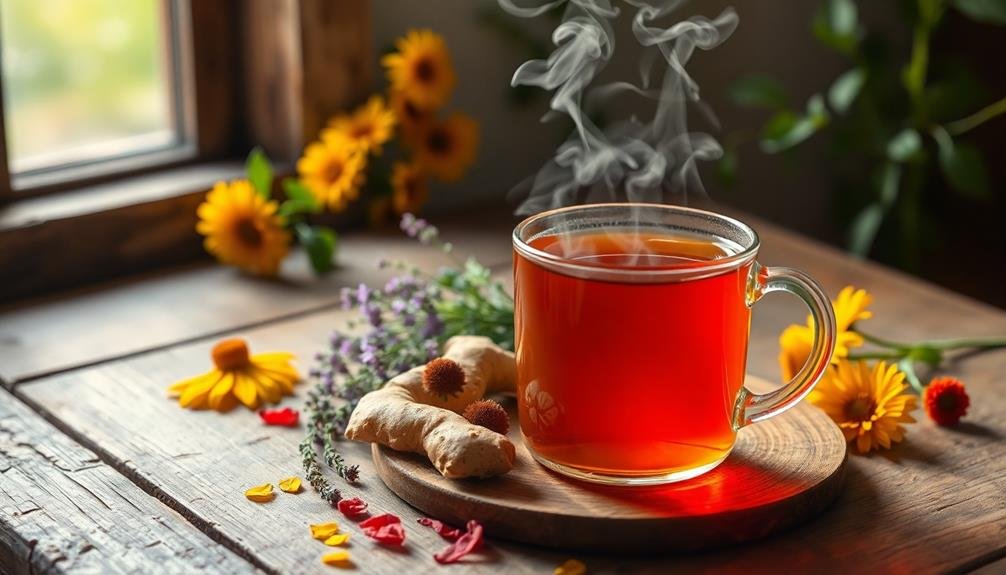
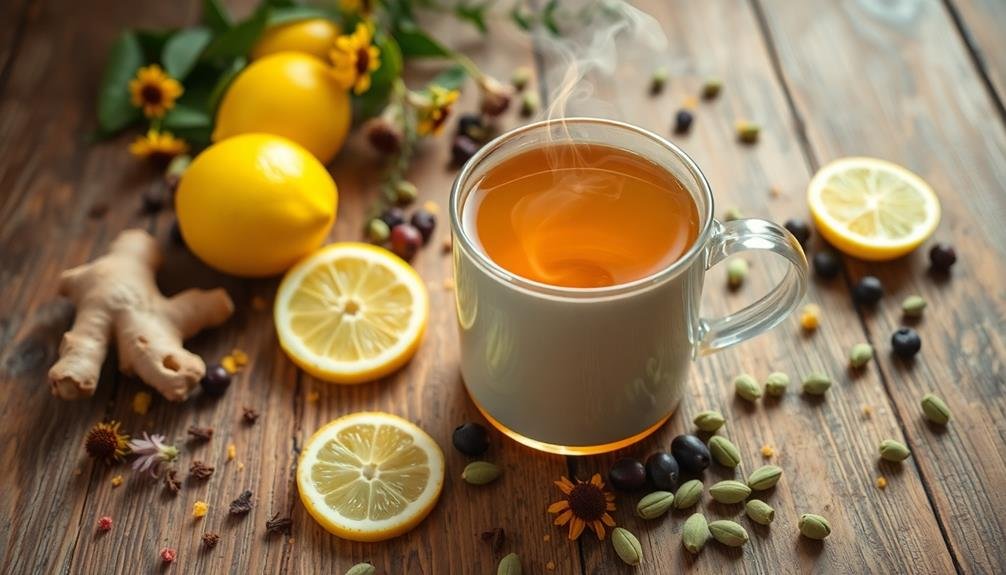
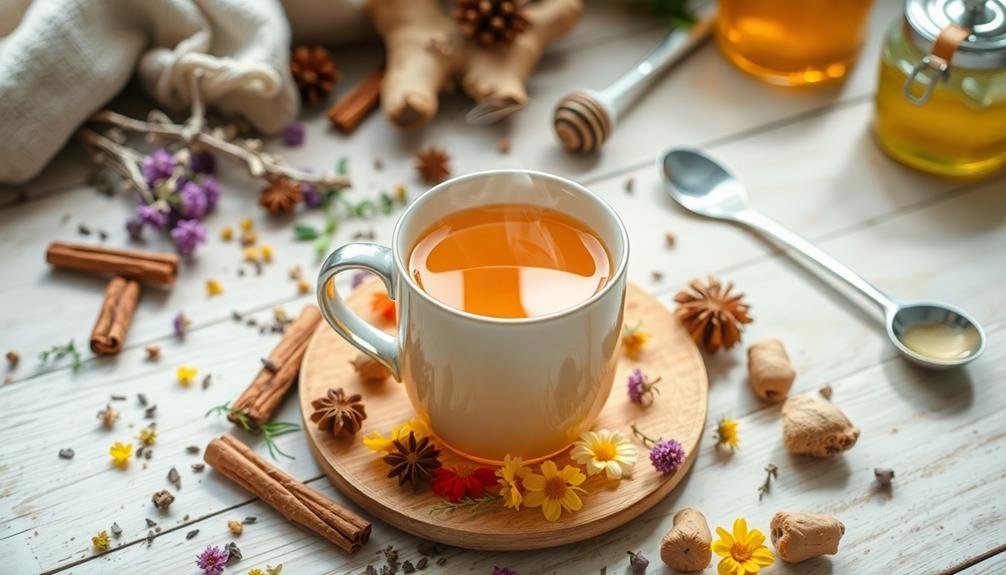
Leave a Reply